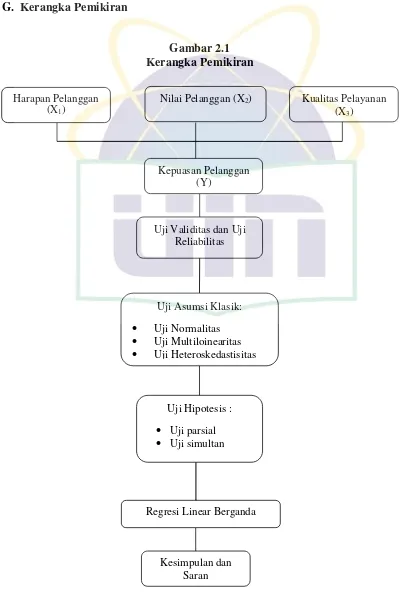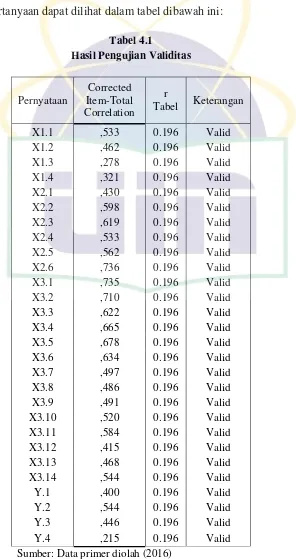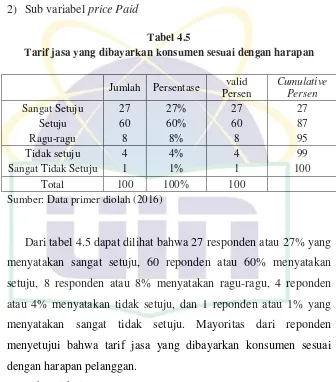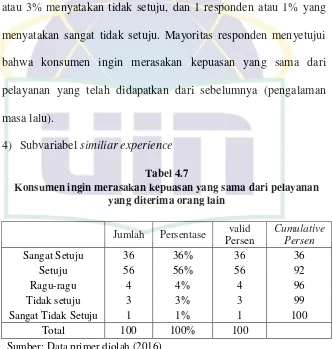Informasi Dokumen
- Penulis:
- Abdul Latif
- Pengajar:
- Bapak Dr. Yahya Hamja, MM.
- Bapak Ade Suherlan, SE., MM., MBA.
- Ibu Sri Hidayati, S.Ag., M.Ed.
- Ibu Titi Dewi Warninda, SE., M.Si.
- Ibu Ela Patriani, MM
- Sekolah: Universitas Islam Negeri Syarif Hidayatullah
- Mata Pelajaran: Manajemen
- Topik: Pengaruh Harapan Pelanggan, Nilai Pelanggan, dan Kualitas Pelayanan Terhadap Kepuasan Pelanggan Pada Pengguna Jasa Kereta Commuterline Jabodetabek
- Tipe: skripsi
- Tahun: 2016
- Kota: Jakarta
Ringkasan Dokumen
I. Introduction
This section outlines the background of the research, emphasizing the increasing competition in the transportation sector, particularly in urban areas like Jabodetabek. It discusses the significance of commuter services in alleviating traffic congestion and the necessity for quality service to attract users. The introduction sets the stage for exploring customer expectations, customer value, and service quality as critical factors influencing customer satisfaction.
II. Literature Review
This section reviews relevant literature on key concepts such as marketing, customer expectations, customer value, service quality, and customer satisfaction. It defines marketing as a process aimed at creating value and fulfilling customer needs. The characteristics of services, including intangibility and perishability, are discussed, along with factors that shape customer expectations and value. The review lays a theoretical foundation for understanding how these elements interconnect to influence customer satisfaction.
2.1 Marketing
This subsection defines marketing and its importance in creating and delivering value to customers. It highlights the role of marketing in understanding and meeting customer needs through effective communication and service delivery.
2.2 Customer Expectations
This subsection discusses the factors influencing customer expectations, including prior experiences and service provider communications. It emphasizes the dynamic nature of these expectations and their impact on perceived service quality.
2.3 Customer Value
This subsection explores the concept of customer value as a balance between perceived benefits and costs. It introduces indicators of customer value and their relevance in enhancing customer satisfaction.
2.4 Service Quality
This subsection defines service quality and its dimensions, such as reliability and responsiveness. It discusses the importance of service quality in fulfilling customer expectations and enhancing satisfaction.
2.5 Customer Satisfaction
This subsection defines customer satisfaction and its determinants. It outlines the relationship between customer expectations, perceived service quality, and overall satisfaction.
III. Research Methodology
This section details the research design, including the sampling method, data collection techniques, and analytical methods employed. The study adopts a quantitative approach, utilizing questionnaires to gather data from commuterline users. The methodology ensures a comprehensive understanding of the variables influencing customer satisfaction.
3.1 Research Scope
This subsection defines the scope of the study, focusing on commuterline users in Jabodetabek. It outlines the time frame and locations for data collection, ensuring relevance and accuracy.
3.2 Sampling Method
This subsection describes the accidental sampling technique used to select respondents. It emphasizes the importance of obtaining a representative sample to enhance the validity of the findings.
3.3 Data Collection Techniques
This subsection outlines the primary and secondary data collection methods, highlighting the use of questionnaires to gather quantitative data from respondents.
3.4 Data Analysis Method
This subsection explains the analytical methods used, including regression analysis to determine the relationships between customer expectations, customer value, service quality, and customer satisfaction.
IV. Analysis and Discussion
This section presents the findings of the research, detailing the analysis of customer expectations, value, and service quality in relation to customer satisfaction. It discusses the results of statistical tests and their implications for understanding customer behavior and preferences.
4.1 Overview of Respondents
This subsection provides demographic information about the respondents, offering insights into the characteristics of commuterline users and their service experiences.
4.2 Descriptive Analysis
This subsection presents a descriptive analysis of the responses regarding customer expectations, value, service quality, and satisfaction. It highlights key trends and patterns in the data.
4.3 Hypothesis Testing
This subsection discusses the results of hypothesis testing, detailing the statistical significance of the relationships between the variables. It provides insights into the impact of customer expectations, value, and service quality on satisfaction.
V. Conclusion and Recommendations
This section summarizes the key findings of the research, emphasizing the importance of managing customer expectations and enhancing service quality to improve customer satisfaction. It offers practical recommendations for PT KAI Commuter Jabodetabek to better meet customer needs and expectations.
5.1 Conclusion
This subsection summarizes the research findings, reiterating the significant influence of customer expectations, value, and service quality on customer satisfaction.
5.2 Recommendations
This subsection provides actionable recommendations for improving service delivery and enhancing customer satisfaction based on the research findings.









